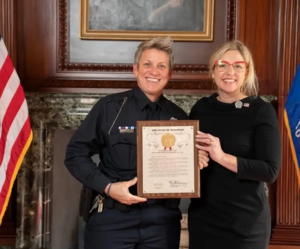A Timeline of Some Important Victories for LGBTQ+ Rights
June 30, 2022
Pride month is coming to an end, and while there are many allies and members of the LGBTQ+ community, there are still people who oppose LGBTQ+ pride and civil progress. The fight for LGBTQ+ rights has been a long battle that is still not over to this day. There are even those who claim that being LGBTQ+ is easy nowadays, but the long struggle for gay and transgender rights suggests otherwise. Most people know about milestone events like those at Stonewall in 1969, but there were so many other events that were pivotal in the fight for LGBTQ+ rights in American history. To celebrate this year’s Pride month, here are some victories that took place as part of liberation movements across the US and even globally.
June 27, 1970 – First pride parade in US history takes place in Chicago
On June 27, 1970, the very first pride parade in US history took place in Chicago from Washington Square Park to the Chicago Water Tower. Morris Kight was an organizer of the parade and the Gay Liberation Front LA Founder. Getting the march to happen was not easy. The Chicago Gay Liberation group sought a permit to march the parade from the Police Commission, but the fee was more than a million dollars and was only disregarded once the American Civil Liberties Union interfered. Kight also faced death threats leading up to the parade’s date. The parade was a protest regarding LGBTQ+ rights while also being a fun parade celebrating pride. It celebrated homosexuality and freedom while fighting for gay and transgender rights.
December 15, 1973 – Homosexuality is no longer considered a mental illness by the APA, the world’s largest psychiatry organization
Homosexuality was classified as a mental illness throughout most of American history. The APA (American Psychological Association) had homosexuality labeled as a mental illness until December 15th, 1973. Their stance is now as follows: “Homosexuality per se implies no impairment in judgment, stability, reliability, or general social and vocational capabilities; Further, the American Psychological Association urges all mental health professionals to take the lead in removing the stigma of mental illness that has long been associated with homosexual orientations.” Homosexuality is now recognized not as a mental illness by the APA, but as part of human identity.
1978 – The pride flag is designed as a symbol for the LGBTQ+ community in the US
In 1978, Gilbert Baker, having been commissioned by Harvey Milk, designed the original pride flag. Baker was an openly gay man and a drag queen, and Milk was one of the first openly gay elected officials of the United States. When coming up with a symbol for Pride, Baker reasoned that a flag would be best as a long-recognized emblem of pride and way to express the identity of the gay community. Baker thought that a rainbow was a flag of sorts in the sky, so he used this and each colored stripe had its own meaning. Thus, the first version of the pride flag was born. Though the flag was not yet created at the time of the first pride parade, it began to be used starting in 1978 in the San Francisco Gay Freedom Pride parade. The flag we know today, however, is slightly different; there is no pink, turquoise, or indigo due to production issues.
April 1, 2001 – The Netherlands becomes the first country to legalize gay marriage
The legalization gay marriage has taken longer than people may think. The earliest date of gay marriage legalization in the world dates back only to 2001, and the country to do so was the Netherlands. Legislation gave same-sex couples the rights to marry, divorce, and to adopt children. The legislation altered the nation’s civil marriage stature to say that “a marriage can be contracted by two people of different or the same sex.” This newly passed bill was, for the most part, widely accepted by the Dutch public and parliament, while only the Christian Democratic Party opposed it along with some conservative groups. The House of Representatives passed the bill on September 12, 2000 and it was passed in the Senate on December 19, 2000. The bill was not active until April 1, 2001.
September 20, 2011 – The “Don’t Ask, Don’t Tell” policy ends with president Obama in office
The “Don’t Ask, Don’t Tell” bill was passed while President Bill Clinton was in office. This bill was issued on December 21, 1993 and went into effect on February 28, 1994. It prevented military personnel from harassing LGBTQ+ members of the military, but it required those members to remain closeted and hide their identity as gay, lesbian, bisexual, transgender, or otherwise. Service members who were openly LGBTQ+ were not allowed to serve in the military. Troops were banned from discussing same-sex relationships as well as disclosing their sexual orientation. It wasn’t until September 20, 2011, that the bill was finally overturned with President Barack Obama in office, allowing LGBTQ+ people to serve in the military. LGBTQ+ service members who were discharged before for their orientation were offered their position back.
June 26, 2015 – Supreme Court rules in Obergefell v. Hodges that same-sex marriage is protected by the 14th Amendment
The 26th of June marks an important date in the history of gay rights, for it is the day when the Supreme Court ruled that the right to marriage for same-sex couples is protected by the 14th Amendment. This decision led to the legalization of gay marriage throughout the entirety of the United States and its territories. The Supreme Court case was a culmination of multiple court cases that came from Michigan, Ohio, Kentucky, and Tennessee, with six cases in total and sixteen same-sex couples represented. When these cases were taken to the Supreme Court, it was ruled 5-4 that same-sex couples must be allowed the right to marry, creating a significant landmark in American history. Supreme Court Justice Clarence Thomas recently suggested in a concurring opinion to the case Dobbs v. Jackson that Obergefell v. Hodges, along with the landmark LGBTQ+ rights case Lawrence v. Texas, be revisited, demonstrating that LGBTQ+ rights continue to be under attack in the United States.
Pride month’s importance today: Why does it still matter?
There is a lot of history behind the rights that the LGBTQ+ community have today. Celebrating the hard work and effort put into LGBTQ+ movements is highly significant to those who are part of the community, and Pride is a great way for allies to show support. Pride month is in June because the Stonewall riots took place near the end of June, which already speaks volumes as to why acknowledging LGBTQ+ history is so important. Members of the LGBTQ+ community have faced oppression and judgment for years without support, and now that there’s a month designated for supporting the community, it is crucial that we celebrate it to continue to progress the fight for LGBTQ+ civil liberties.













